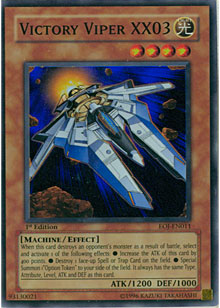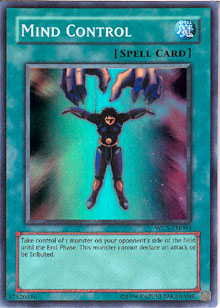Last week we looked at two of the tech cards that defined the 2008 World Championships just a couple weeks ago in Berlin. Today, we’re going to go deeper and look at three more cards that were played in new and unique ways at that event. By doing so, we’ll find ideas that can be adapted for your tournaments, even though the World Championships are played under a different incarnation of the Advanced format. Let’s start with my personal favorite from the highlight reel!
Victory Viper XX03
The World Championships opened with a huge feature match between Singapore’s Michael Santoso and Japan’s Takahiro Kawaguchi. While Kawaguchi ran Lightsworn, Santoso aimed to innovate with a Light Beatdown deck that was powered by recruiter monsters—specifically Shining Angel and Nova Summoner. After a conservative opening from both competitors, Kawaguchi  tributed for Celestia, Lightsworn Angel, blowing away his opponent’s Garoth, Lightsworn Warrior and Mirror Force to really break open the duel. A direct attack from Celestia then dropped Santoso to 3500 life points. He was low on hand presence and needed to make a big move if he was to mount a comeback.
tributed for Celestia, Lightsworn Angel, blowing away his opponent’s Garoth, Lightsworn Warrior and Mirror Force to really break open the duel. A direct attack from Celestia then dropped Santoso to 3500 life points. He was low on hand presence and needed to make a big move if he was to mount a comeback.
He did, and it was one that would set the pace for a series of surprises over the course of the weekend. On the turn that followed, Santoso summoned Shining Angel, and rammed it into Celestia. Santoso special summoned his one copy of Victory Viper XX03 from his deck and sent it to attack. What happened next was unbelievable.
He pitched Honest from his hand to boost Victory Viper up and over Celestia’s 2300 ATK, giving the Viper 3500 ATK total. Celestia went down and that’s where the real magic started: Santoso opted to use Victory Viper XX03’s third effect, which can be activated when the Viper destroys a monster in battle. That effect summons an Option Token, which mimics the attribute, type, DEF, and most importantly the ATK of the Viper.
Normally an Option Token would have just 1200 ATK, but since Honest’s effect lasts for the entire turn, Victory Viper remained at 3500 ATK points. The Option Token copied it, and Santoso suddenly had a pair of 3500 ATK monsters. With the field cleared, he sent the Option Token to score a quick 3500 damage with a direct attack, a devastating move that simply came out of nowhere.
Victory Viper’s strength in Santoso’s deck came from two pieces of support: the combo power of Honest and the search power provided by Shining Angel. Right now there are lots of decks playing multiple copies of Honest, including several Light Beatdown variants, but Shining Angel is relatively unpopular aside from a handful of Counter Fairy variants. Still, if a deck comes along that runs those two cards together, then Victory Viper XX03 will be a potent addition. Shining Angel has seen play on and off for years, but Michael Santoso innovated the toolbox of monsters it searches out, changing how we’ll look at Shining Angel forever.
Malevolent Catastrophe
But of course, Santoso didn’t win that match. Instead, it would be Takahiro Kawaguchi who would claim victory in that duel and others on the way to securing his seat in the Top 8. His victory came down to one stellar move that shattered the spine of Santoso’s strategy.
Coming off a big Morphing Jar play, Santoso didn’t seem to know what to do with all of his extra cards. He’d set three of them to his spell and trap zone in preparation to flip summon Morphing Jar, and one turn later he filled his back row to capacity. Kawaguchi was left behind in card presence and with no immediate offense, and Santoso wiped him out by activating Torrential Tribute in response to his own summon, clearing the field so he could bring out Nova Summoner and make a direct attack.
Then it all went terribly wrong. Kawaguchi couldn’t block the damage from Nova Summoner’s push, but he flipped Malevolent Catastrophe instead, costing Santoso a whopping four cards! Brain Control, Smashing Ground, Mystical Space Typhoon, and the Royal Oppression that had been holding Kawaguchi back were all blown away with a single card, and victory was academic. Santoso was just out-matched, crippled by Kawaguchi’s devastating play.
The best part? Malevolent Catastrophe is just as playable in the regular Advanced format as it was at Worlds. Solemn Judgment is everywhere, and destroying it before you try to activate or summon whatever it would be played to negate means that you actually get to make your game-breaking moves instead of losing them to a piddling trap card. That’s obvious: it’s the same reason why Dust Tornado is so good right now. But Solemn Judgment has created some unique trends that you can take advantage of with Malevolent Catastrophe.
Namely, most duelists set an additional card when they set Solemn, reasoning that should anything threaten their other face down, Solemn can be used to keep it around. At the same time, the mere presence of a non-Solemn card in the back row can draw out removal that would otherwise destroy the Solemn itself.
But those trends and theories add up to nothing but a terrible beating when you’re running Malevolent Catastrophe. Catastrophe doesn’t just blow away Solemn Judgment—it’ll take that second card with it as well, effectively acting as a second, third, or even fourth copy of Heavy Storm that activates with far more advantageous timing. It’s so easy to destroy two cards for your one with Catastrophe at the moment, that it’s a perfect call for many matchups. It’s only going to get better too, with Zombies threatening to become a big archetype over coming months. That deck’s frequent attacks provide many opportunities to activate Malevolent Catastrophe, while Zombies’ use of Card of Safe Return is an Achilles’ heel that Catastrophe can help you exploit.
On the other side of the equation are decks maining Royal Oppression, which frequently have multiple spell or trap cards on the field. Catastrophe can actually be effective tech for Zombies as well, or anything else that likes not losing to Oppression. With Oppression decks on the rise lately, this new tech couldn’t have come at a better time.
Mind Control
Finally, one card that is already starting to become popular in the Advanced format saw notable play at Worlds, albeit in a very different context. Mind Control was sided in triplicate by fourth-place competitor Claudio Kirchmair and World Champion Kazuku Mutsuoka. It was also main decked by Terence Figuiredo. Figuiredo didn’t make Day 2—he narrowly missed out with an eleventh-place finish. But eleventh place at Worlds is still a huge achievement, and  Figuiredo’s use of the card would be indicative of this tech pick’s future.
Figuiredo’s use of the card would be indicative of this tech pick’s future.
Mind Control hasn’t been an obscure card as a side deck choice: Joseph Rechis played it to a fourth-place finish at Shonen Jump Championship St. Louis, and enterprising Gladiator Beast duelists seeking an edge in the mirror match took note. It’s been seeing increasing use ever since, but now, with Synchro monsters giving virtually any deck something to do with that pilfered monster, Mind Control is suddenly seeing testing in all sorts of main decks and with good reason.
Mind Control provides two big services: first, it gets you another monster to Synchro summon with, just like how Gladiator players use it to make contact Fusions in the mirror match. Second, it removes a monster from the opponent’s side of the field, making it easier for you to make a direct attack. It also does a few other handy things like blowing away Spirit Reaper, but you’ll generally find that those two chief purposes are the ones you’ll be playing it for.
Level-2 Tuners are really what make Mind Control so good. By taking a level-4 monster with Mind Control you can summon Goyo Guardian, or if you were beaten to the punch, you can swipe your opponent’s Goyo and trade it in for Stardust Dragon, Red Dragon Archfiend, or Thought Ruler Archfiend. People have recently started to realize that controlling the largest monster on the field—even if it’s just Elemental Hero Neos Alius or a boosted Gladiator Beast Laquari—often makes for a win. Goyo Guardian is relatively easy to summon and has huge ATK, so having a card that lets you both summon it or trump it when it’s played against you is exceptionally valuable. Off the top of my head I can name five level-2 Tuners, and two of them are already being hailed as exceptionally playable: Jutte Fighter and Krebons from The Duelist Genesis. There’s also Nitro Synchron, plus Magna Drago and Frequency Magician from the Yu-Gi-Oh! 5D's starter deck. We’re only one booster set deep into the 5D’s era, and this strategy is already completely viable. With more Tuners in each upcoming set, and more Synchros to trade them for, Mind Control just gets better and better.
If you haven’t read through the coverage from the World Championships yet, I’d urge you to do so. Every year it’s a showcase for some of the world’s finest dueling talent, and the latest Championship was played in an especially good format. There’s lots to be learned from the game’s best, so click on over and check it out.
That finishes up our look at Worlds tech, but join me next week and we’ll look at one of the most important (not to mention underrated) cards from The Duelist Genesis. My choice might surprise you, but by the time we’re finished, you might see a card you own in a totally new light.
‘Til then, I’m . . .
—Jason Grabher-Meyer